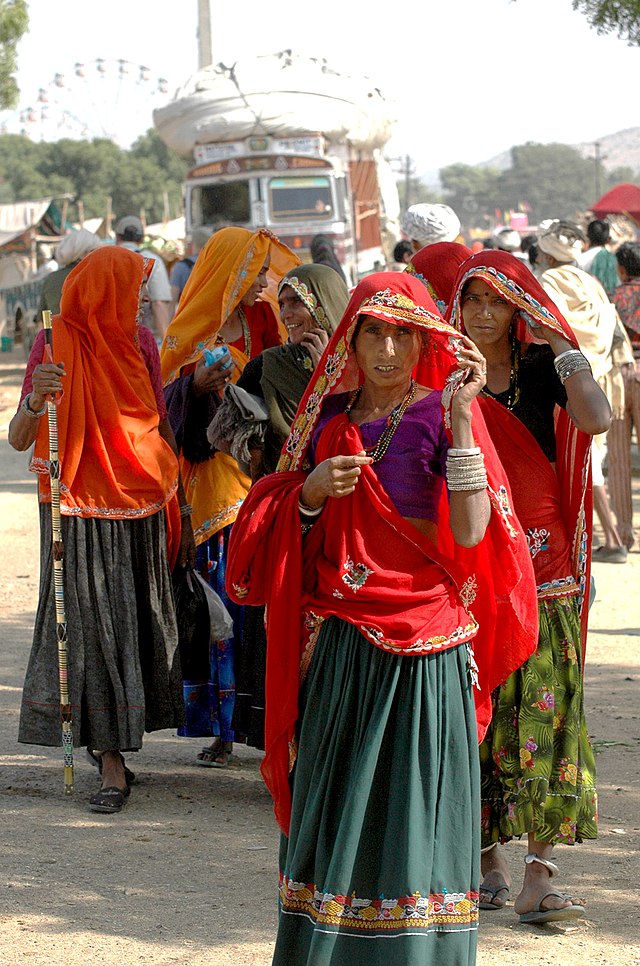The dupattā, also called chunni, chunari, chundari, lugda, rao/rawo, gandhi, pothi, orna, and odhni is a long shawl-like scarf traditionally worn by women in the Indian subcontinent.[1] Traditionally, in India, the dupatta is part of the women's lehenga or ghagra/chaniya choli. A lehenga is a three-piece outfit which is made up of a skirt, called a ghagra or chaniya; a blouse, called a choli, and a dupatta. The dupatta is worn over one shoulder, and traditionally, married women would also wear the dupatta over the head in temples or in front of elders.

The dupatta is also worn as part of the shalwar kameez which is worn by women in South Asia, particularly in parts of Northern India and Deccan region. The Punjabi suit is worn in Punjab and Pakistan, it is another three piece outfit made up of trousers, called pyjama or salwar; a top, called a kurta or kameez, and the dupatta.
Etymology
The Hindi-Urdu word dupattā (दुपट्टा, دوپٹہ),[2] meaning "shawl of doubled cloth," stemming from Sanskrit, is a combination of du- (meaning "two", from Sanskrit dvau, "two", and dvi-, combining form of dvau and paṭṭā (meaning "strip of cloth," from paṭṭaḥ),[3] i. e., stole.
History

Early evidence of the dupatta can be traced to the Indus valley civilization, where the sculpture of a priest-king whose left shoulder is covered with some kind of a shawl-like scarf suggests that the use of the dupatta dates back to this early Indic culture.[4][5] Early Sanskrit literature has a wide vocabulary of terms for the veils and scarfs used by women during the ancient period, such as avagunthana (cloak-veil), uttariya (shoulder-veil), mukha-pata (face-veil), and siro-vastra (head-veil).[6] The dupatta is believed to have evolved from the ancient uttariya.[7][8][9]
Use


The dupatta is worn in many regional styles across South Asia. There is no single way of wearing the dupatta, and as time evolves and fashion modernizes, the style of the dupatta has also evolved.
A dupatta is traditionally worn over the left shoulder in India, and tucked in to a skirt on the opposite side. However, the dupatta can be free hanging over the shoulder, or, across the neck and behind both shoulders. A modern variation is to allow the length of the dupatta to drape elegantly around the waist and through the arms at the front. The material for the dupatta varies, but it is normally light and long, allowing for flow and variation.
When the dupatta is worn with the shalwar kameez, it covers the chest, creating a U or V shape.[citation needed] In addition to wearing the dupatta when going out in public, South Asian women wear the dupatta as a veil when entering a mandir, church, gurdwara.[11][12][13] In the context of the COVID-19 pandemic, it was not considered proper for use as a cloth face mask as it is a religious cloth.[14]
A dupatta used as a covering for the head and face is called a ghoonghat. It was customary for new brides to wear a ghoonghat to protect them from the evil eye. In Nepal a dupatta or similar shawl is called a pachaura.[15]
Types of Dupatta
There are rich variety of dupattas that India has to offer, each with its own unique style and cultural significance. From the vibrant Phulkari dupattas of Punjab to the intricate Banarasi silk dupattas, there's something for everyone to enjoy and incorporate into their wardrobe.[16]
- Phulkari Dupattas: These colorful creations bring the essence of Punjab's traditional fashion to life with their intricate floral embroidery, adding a burst of color to any outfit.
- Bandhani or Bandhej Dupattas: Originating from Gujarat and Rajasthan, these tie-dye dupattas feature classic motifs and vibrant colors, perfect for those who appreciate traditional craftsmanship.
- Banarasi Silk Dupattas: Exuding elegance and opulence, Banarasi silk dupattas are adorned with exquisite zari brocade work and traditional motifs, making them a timeless symbol of luxury.
- Printed Dupattas: Offering a blend of traditional appeal and contemporary patterns, printed dupattas are versatile and can be paired with a variety of outfits, adding a touch of chic style.
- Velvet Dupattas: Luxurious and sophisticated, velvet dupattas are embellished with classic elements like zari and Zardozi, making them perfect for creating stylish and refined looks.[17]
Each type of dupatta has its own charm and beauty, reflecting the rich cultural heritage of India. Whether worn with a simple kurta or a glamorous saree, dupattas truly add a touch of elegance and tradition to any ensemble.
Gallery
- The dupatta's use as protection against dust or the sun
- A Punjabi Sikh woman with blue chunni
- A dupatta shop in Dhaka, Bangladesh
- A dupatta shop in Dhaka, Bangladesh
- Bandhani dupatta
- A Bangladeshi draped in dupatta
- A Nepali in a modern style of draping dupatta over the neck
- A Sikh in a salwar kameez
References
External links
Wikiwand in your browser!
Seamless Wikipedia browsing. On steroids.
Every time you click a link to Wikipedia, Wiktionary or Wikiquote in your browser's search results, it will show the modern Wikiwand interface.
Wikiwand extension is a five stars, simple, with minimum permission required to keep your browsing private, safe and transparent.








